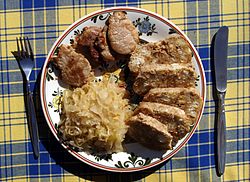Our website is made possible by displaying online advertisements to our visitors.
Please consider supporting us by disabling your ad blocker.
Czech cuisine
This article includes a list of general references, but it lacks sufficient corresponding inline citations. (February 2014) |



| Part of a series on the |
| Culture of the Czech Republic |
|---|
 |
| Czech Republic portal |
Czech cuisine has both influenced and been influenced by the cuisines of surrounding countries and nations. Many of the cakes and pastries that are popular in Central Europe originated within the Czech lands. Contemporary Czech cuisine is more meat-based than in previous periods; the current abundance of farmable meat has enriched its presence in regional cuisine. Traditionally, meat has been reserved for once-weekly consumption, typically on weekends.
The body of Czech meals typically consists of two, or sometimes more, courses; the first course is traditionally soup, and the second course is the main dish. If a third course is eaten, which mainly happens at more festive occasions, it is usually a sweet dessert or compote (kompot). In the Czech cuisine, thick soups and many kinds of sauces, both based on stewed or cooked vegetables and meats, often with cream, as well as baked meats with natural sauces (gravies), are popular dishes usually accompanied with beer, especially Pilsner, that Czechs consume the most in the world. Czech cuisine is also very strong in sweet main courses, a unique feature in European cuisines.
Previous Page Next Page


